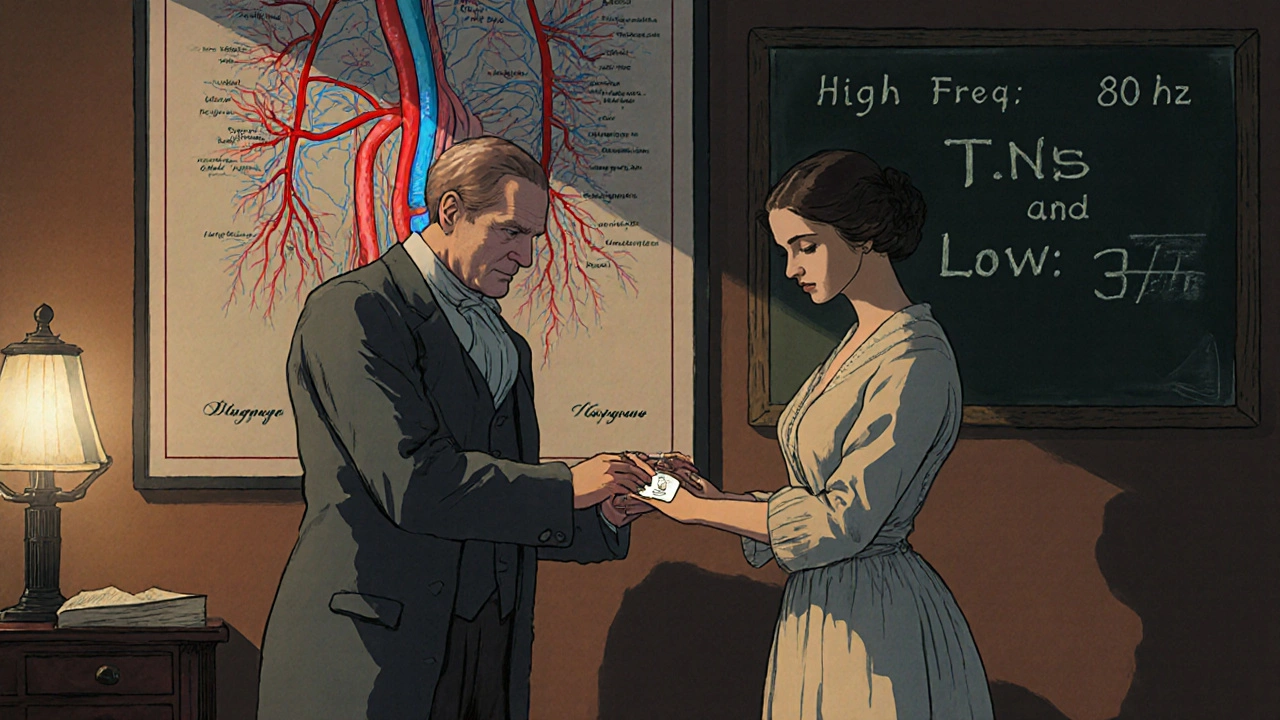18 Nov 2025
- 11 Comments
When your back aches, your knees throb, or labor contractions hit hard, reaching for a pill isn’t always the best or safest option. That’s where TENS therapy comes in - a simple, non-drug way to ease pain using tiny electrical pulses. No prescriptions. No opioids. Just a small device you can hold in your hand and use at home.
Transcutaneous Electrical Nerve Stimulation, or TENS, has been around since the 1970s, but it’s seeing a big comeback. With the opioid crisis still affecting millions, doctors and physical therapists are turning more often to tools like TENS to help people manage pain without adding chemicals to their bodies. And for good reason: studies show it can cut opioid use after surgery by nearly a third and reduce nausea and drowsiness from those drugs too.
How TENS Actually Stops Pain
TENS doesn’t fix the source of your pain - like a torn tendon or arthritic joint. Instead, it interrupts how your brain hears the pain signal. Think of it like turning down the volume on a loud alarm.
The science behind it goes back to 1965, when researchers Ronald Melzack and Patrick Wall proposed the Gate Control Theory. They found that when you stimulate large nerve fibers (the ones that feel touch and vibration), they can block smaller pain fibers from sending signals to your brain. It’s like closing a gate in your spinal cord.
Modern TENS machines do this by sending mild electrical pulses through sticky pads placed on your skin. These pulses create a tingling or buzzing feeling - not pain, but strong enough to notice. That sensation crowds out the pain signals before they reach your brain.
There’s another trick TENS can pull off. At lower frequencies (2-5 pulses per second), it triggers your body to release natural painkillers - endorphins and enkephalins. These are your brain’s version of morphine. That’s why some people feel relief that lasts even after they turn the machine off.
Types of TENS Settings - And When to Use Them
Not all TENS units are the same. The settings you choose matter more than you think. Using the wrong one can mean you get nothing but a tickle.
- Conventional TENS (High Frequency): 50-100 Hz, low intensity. Best for acute pain - think a recent sprain, post-surgery soreness, or labor contractions. It works fast by blocking pain signals. Most people feel a strong, comfortable buzz.
- Acupuncture-like TENS (Low Frequency): 2-5 Hz, higher intensity. Used for chronic pain like arthritis or long-term back issues. It takes longer to kick in (15-30 minutes) but can give you hours of relief by boosting your body’s natural opioids.
- Burst Mode: Combines both. High-frequency bursts (100 Hz) delivered 2-3 times per second. Good for mixed pain types - say, a flare-up of sciatica with both sharp and dull pain.
- Intense TENS: High amplitude, short bursts (5-15 minutes). Creates a sharp, tapping sensation. Used less often, mostly for stubborn pain that doesn’t respond to other settings. Not for beginners.
Most home units come with pre-set programs labeled “acute,” “chronic,” or “muscle.” Stick with those at first. If you’re not feeling anything after 10 minutes, you probably need to increase the intensity - not the frequency. Many people give up too soon because they set it too low.
Where to Place the Electrodes
Placement is everything. Put the pads in the wrong spot, and you’ll get zero relief.
The golden rule: place electrodes within 2-3 centimeters of your pain point. For lower back pain, put one on each side of your spine, just above the hips. For knee pain, one above the kneecap, one below. For shoulder pain, one on the front of the deltoid, one on the back.
You can also place them over nerve pathways. For sciatica, try placing one near the lower back and another down the back of the thigh. For carpal tunnel, put one on the wrist and one on the forearm.
A 2021 study of 342 patients found that 41% of TENS failures happened because the pads were placed incorrectly. Don’t guess. Look up diagrams for your condition. Many physical therapists give out printed guides. If you’re unsure, ask one - even one 30-minute session can save you weeks of frustration.

Who Benefits Most - And Who Doesn’t
TENS isn’t magic. It works best for specific types of pain.
Great for:
- Post-surgical pain
- Arthritis (knee, hand, hip)
- Muscle strains and sprains
- Lower back pain (especially short-term flare-ups)
- Labor pain
- Neuropathic pain like diabetic nerve pain
Less effective for:
- Fibromyalgia (only about 38% of users report meaningful relief)
- Widespread chronic pain with no clear source
- Pain caused by internal organ issues (like kidney stones or gallbladder attacks)
And here’s something important: if you’re already on opioid medication, low-frequency TENS might not work as well. Studies show opioids can block the same brain receptors that TENS tries to activate. That doesn’t mean it won’t help at all - just that you might need higher intensity or stick to high-frequency settings.
Real User Experiences
People love TENS when it works. On Amazon, 78% of users say they feel relief right away. They like that it’s portable, quiet, and doesn’t make them drowsy.
One Reddit user, u/BackPainWarrior, wrote: “TENS works great for my sciatica flare-ups but only if I crank it to 85% intensity - anything less just tickles. Problem is, the battery dies in 90 minutes at that setting.”
That’s the trade-off. Higher intensity = better pain control = shorter battery life. Most units last 8-10 hours at moderate settings. At max, you might get 60-90 minutes.
Another common complaint? Skin irritation. About one in three users report redness or itching under the pads. Use conductive gel to reduce resistance and improve contact. Clean your skin with alcohol before applying pads. Replace electrodes every 10-15 uses.
And yes - some people just don’t respond. That’s normal. Pain is personal. What works for your neighbor might do nothing for you. But if you’ve tried it with proper placement and intensity, and still feel nothing after 15 minutes, it’s probably not for you.

What to Look for in a TENS Unit
You don’t need to spend $500. But don’t buy the $20 gadget from a discount store either.
Look for these features:
- Dual channels (so you can treat two areas at once)
- Adjustable intensity (0-80 mA range)
- Multiple modes (high, low, burst)
- Clear display and easy buttons
- Rechargeable battery
- FDA-cleared (check the FDA database)
Top brands like Omron, Chattanooga, and TechCare offer reliable units. Omron’s Max Power model comes with a 147-page manual - yes, really. Basic models might give you 8 pages. If you’re serious about using it, go for the detailed one.
And now, there’s something new: AI-powered TENS. In May 2023, the FDA cleared the first smart device - NeuroLoop AI - that adjusts settings automatically based on your body’s feedback. Early trials showed 44% more pain relief than traditional units. These are still expensive, but they’re the future.
How to Get Started
Follow this simple plan:
- Get an FDA-cleared TENS unit.
- Read the manual - or find a reliable guide online for your condition.
- Clean and dry your skin where the pads will go.
- Place electrodes within 2-3 cm of your pain or over the nerve path.
- Start with low intensity and high frequency (80 Hz). Increase slowly until you feel a strong, comfortable buzz.
- Use for 20-30 minutes, up to 3 times a day.
- If no relief after 15 minutes, try increasing intensity - not frequency.
- Track your pain before and after. Use a scale from 1 to 10.
Most physical therapists recommend 3-5 supervised sessions to learn proper technique. If you’re in a clinic, ask if they offer a demo. If you’re doing it at home, YouTube has good tutorials - but stick to ones from certified PTs or hospitals.
What’s Next for TENS Therapy
The future is smart. In September 2023, the NIH funded research into electrodes with built-in sensors that monitor skin contact and adjust current automatically. Imagine a patch that knows when it’s losing connection and fixes it on its own.
More pain clinics are adding TENS to digital health programs. By 2025, the CDC predicts a 35% increase in primary care doctors recommending TENS for chronic pain. Insurance coverage is growing too - Medicare reimburses up to $150 for a TENS unit under code E0720.
And with over 28% of U.S. physical therapy clinics using TENS as a first-line treatment, it’s no longer a fringe tool. It’s becoming standard.
Still, don’t expect miracles. TENS won’t cure your arthritis. It won’t fix a herniated disc. But for many, it’s the difference between taking a pill every day and being able to move, sleep, and live without fear of side effects.
If you’re tired of meds that make you foggy, or you’re looking for something to try before another injection or surgery - TENS is worth a shot. Just make sure you do it right. Placement. Intensity. Patience. It’s not complicated. But it does take a little effort.
Can I use TENS if I have a pacemaker?
No. TENS sends electrical pulses through your body, and that can interfere with pacemakers, defibrillators, or other implanted electronic devices. Even if your device is labeled "TENS-safe," always check with your cardiologist first. The risk isn’t worth it.
Is TENS safe during pregnancy?
Yes - but avoid using it on your abdomen or lower back during early pregnancy. Many women use TENS for labor pain, and it’s considered safe in the second and third trimesters. Still, talk to your OB-GYN before starting. Some providers recommend avoiding it entirely in the first 12 weeks just to be cautious.
How long does it take for TENS to work?
High-frequency TENS (50-100 Hz) often works within minutes - you should feel relief as soon as you turn it on. Low-frequency TENS (2-5 Hz) takes longer - usually 15 to 30 minutes - because it’s triggering your body’s natural painkillers. Don’t give up too early. Wait at least 20 minutes before deciding it’s not working.
Can I use TENS every day?
Yes. Most people use it 2-3 times a day for 20-30 minutes each session. There’s no evidence that daily use causes harm. Just replace the electrodes every 10-15 uses, and don’t leave the pads on your skin for longer than 30 minutes at a time to avoid irritation.
Does insurance cover TENS units?
Some do. Medicare and many private insurers cover TENS units if prescribed by a doctor for chronic pain, especially if you’ve tried other treatments first. You’ll need a prescription and documentation showing it’s medically necessary. The reimbursement code is E0720, and Medicare pays around $150 per unit. Check with your provider - coverage varies.
What’s the difference between TENS and EMS?
TENS targets nerves to block pain. EMS (Electrical Muscle Stimulation) targets muscles to make them contract - used for muscle recovery or rebuilding strength after injury. Some devices combine both, but don’t confuse them. Using EMS for pain relief won’t work the same way. Always check your device’s settings.
If you’re considering TENS, start small. Borrow a unit from a friend, rent one from a clinic, or buy an affordable model. Try it for two weeks with proper placement and intensity. Keep a pain journal. If you get even 30% relief, it’s worth keeping. If not, you’ve spent less than a dinner out - and you’ve tried something that could’ve changed your daily life.


Saket Sharma
November 19, 2025TENS is just placebo with wires. If you need electricity to feel human, you’re already losing. Real pain management doesn’t need a 100Hz buzz to distract you from your own body’s failure.
Joshua Casella
November 19, 2025Actually, the Gate Control Theory is well-supported in peer-reviewed literature. TENS isn’t magic, but it’s evidence-based. For chronic low back pain patients who can’t tolerate NSAIDs or opioids, it’s a legitimate tool. The key is proper electrode placement and intensity - not dismissing it because it’s non-pharmaceutical.
Ronald Stenger
November 20, 2025Why are we letting Canadians and Indians dictate pain management? This is American innovation - FDA-cleared, clinically validated, and cost-effective. If you’re not using TENS in your rehab protocol, you’re doing your patients a disservice. We’ve got better tech than Europe or Asia - stop pretending otherwise.
Sameer Tawde
November 22, 2025Just tried TENS for my knee pain last week. Set it to 80Hz, placed pads above and below the kneecap - felt it immediately. No more walking like a 90-year-old. Seriously, if you’re skeptical, borrow a unit. 20 minutes. No cost. No side effects. What’s the downside?
Alex Czartoryski
November 23, 2025My uncle used one after his hip replacement. Said it felt like a thousand tiny bees dancing on his skin. He refused to go back to pills. Now he’s got the unit mounted on his walker like a cybernetic pacifier. I’m not judging. I’m just saying - if it works, why fight it?
Victoria Malloy
November 25, 2025I used TENS during labor. It didn’t erase the pain, but it gave me something to focus on besides screaming. The tingling felt like control. That mattered more than I expected.
Gizela Cardoso
November 25, 2025Been using mine for 8 months. Skin irritation is real - switched to conductive gel and now I get 15 uses per pad. Also, the battery on my cheap unit dies fast at max setting. Worth it for the 30% pain drop, though.
Andrea Johnston
November 26, 2025Let me guess - you’re one of those people who thinks if you zap your back with electricity, you’re somehow ‘doing something.’ You’re not fixing the disc. You’re not healing the nerve. You’re just making your brain ignore the screaming for 30 minutes. That’s not treatment. That’s denial with wires.
Scott Macfadyen
November 26, 2025My PT gave me a unit after my rotator cuff rehab. I thought it was BS. Tried it at 50Hz, low intensity - nothing. Then I cranked it to 75% and put the pads right on the supraspinatus. Holy shit. Felt like someone turned off a fire alarm in my shoulder. Now I use it every morning. Don’t be lazy with placement.
Chloe Sevigny
November 28, 2025The neurophysiological mechanism is elegant - gate control, endogenous opioid release - but the clinical efficacy is heterogenous. The placebo component is non-trivial, and publication bias in consumer device studies is rampant. We must distinguish between statistically significant and clinically meaningful outcomes. TENS is not panacea. It is, however, a non-invasive modality worthy of inclusion in multimodal analgesia protocols - provided it is administered with clinical precision, not retail consumerism.
Denise Cauchon
November 29, 2025My sister’s a nurse in Toronto. She says 80% of patients who try TENS stick with it - even the ones who say they ‘don’t believe in it.’ She calls it the ‘silent revolution.’ And honestly? I think she’s right. We’re so obsessed with pills and surgery, we forget the body can be talked to - not just blasted.